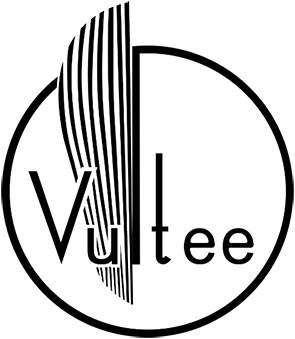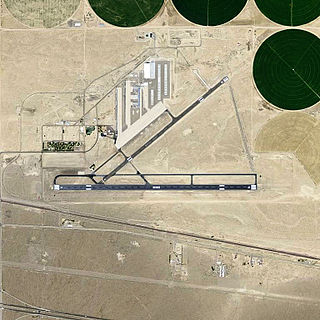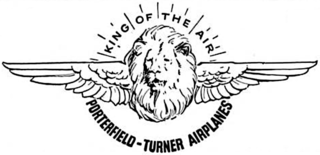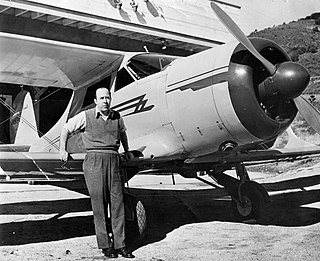Related Research Articles
The Curtiss-Wright Corporation is a manufacturer and services provider headquartered in Davidson, North Carolina, with factories and operations in and outside the United States. Created in 1929 from the consolidation of Curtiss, Wright, and various supplier companies, the company was immediately the country's largest aviation firm and built more than 142,000 aircraft engines for the U.S. military during World War II.

Ontario International Airport is an international airport 2 mi (3.2 km) east of downtown Ontario, in San Bernardino County, California, United States, about 38 mi (61 km) east of downtown Los Angeles and 18 mi (29 km) west of downtown San Bernardino. It is owned and operated under a joint-powers agreement with the city of Ontario and San Bernardino County.

The China National Aviation Corporation was a Chinese airline which was nationalized after the Chinese Communist Party took control in 1949, and merged into the People's Aviation Company of China (中國人民航空公司) in 1952. It was a major airline under the Nationalist government of China until the 90s.

Stearman Aircraft Corporation was an aircraft manufacturer in Wichita, Kansas. Although the company designed a range of other aircraft, it is most known for producing the Model 75, which is commonly known simply as the "Stearman" or "Boeing Stearman".

The Consolidated Aircraft Corporation was founded in 1923 by Reuben H. Fleet in Buffalo, New York, the result of the Gallaudet Aircraft Company's liquidation and Fleet's purchase of designs from the Dayton-Wright Company as the subsidiary was being closed by its parent corporation, General Motors. Consolidated became famous, during the 1920s and 1930s, for its line of flying boats. The most successful of the Consolidated patrol boats was the PBY Catalina, which was produced throughout World War II and used extensively by the Allies. Equally famous was the B-24 Liberator, a heavy bomber which, like the Catalina, saw action in both the Pacific and European theaters.

Vultee Aircraft, Inc., was an aircraft manufacturer founded in 1939 in Los Angeles County, California, when the Vultee Aircraft Division of the aviation holding company AVCO was reorganized as an independent company. It had limited success before merging with the Consolidated Aircraft Corporation on March 17–18, 1943, to form the Consolidated Vultee Aircraft Corporation − or Convair.

Norton Air Force Base (1942–1994) was a United States Air Force facility 2 miles (3.2 km) east of downtown San Bernardino in San Bernardino County, California.

Barstow-Daggett Airport is a county-owned public airport in San Bernardino County, California, United States. It is five miles (8 km) east of Daggett and 14 miles (23 km) east of Barstow. Built in 1933, it is the oldest of the six airports operated by San Bernardino County.
KPRO were the call letters of a radio station in Riverside County, California. It was at 1440 on the dial and later 1570.

The Porterfield Aircraft Corporation was an American aircraft design and manufacturing company founded in 1934 in Kansas by Edward E. Porterfield.
The Lockheed Propulsion Company was a division of the Lockheed Aircraft Corporation located at 1500 Crafton Avenue in the Mentone, California area northeast of Redlands, California, adjacent to the Santa Ana River, from 1961 to 1975. It developed, tested and produced solid rocket motors and propellant used in military and National Aeronautics and Space Administration applications.

Butler International was a United States company in the airplane service, trucking, and technical-management industries. Founded as the Chicago, Illinois–based Butler Aviation in 1947, the company spread across the United States and acquired various other aviation companies, becoming by 1970 the country's largest aviation services company. In 1974, reflecting a diversity of business interests and services in Europe, it was renamed to Butler International. Once a "giant of the general aviation industry", the aviation division was sold in 1992 and merged in 1998 into Signature Flight Support, a company run by the British company Signature Aviation. The rest of the company was sold and ultimately declared bankruptcy in 2009, acquired by Butler America, later Butler Aerospace & Defense, a subsidiary of Select Staffing. This successor company, now owned by Indian conglomerate HCL Technologies, works almost entirely as a technical and engineering support provider for Sikorsky Aircraft Corporation.

The pendulum car was an experimental tilting coach built by the Pacific Railway Equipment Company (PERC) in the early 1940s. It used an innovative coiled spring suspension system that allowed the cars to lean into curves, thus increasing passenger comfort during high speed travel. PERC built three cars which were tested on American railroads throughout the 1940s, but the advent of World War II, and their high cost relative to conventional equipment, prevented their wider adoption.

California during World War II was a major contributor to the World War II effort. California's long Pacific Ocean coastline provided the support needed for the Pacific War. California also supported the war in Europe. After the Japanese attack on Pearl Harbor on December 7, 1941, most of California's manufacturing was shifted to the war effort. California became a major ship builder and aircraft manufacturer. Existing military installations were enlarged and many new ones were built. California trained many of the troops before their oversea deployment. Over 800,000 Californians served in the United States Armed Forces. California agriculture, ranches and farms were used to feed the troops around the world. California's long coastline also put the state in fear, as an attack on California seemed likely. California was used for the temporary and permanent internment camps for Japanese Americans. The population grew significantly, largely due to servicemen who were stationed at the new military bases/training facilities and the mass influx of workers from around the U.S. in the growing defense industries. With all the new economy activity, California was lifted out of the Great Depression. Over 500,000 people moved to California from other states to work in the growing economy. California expanded its oil and mineral production to keep up with the war demand.

Tirey Lafayette Ford Jr. was an American businessman, aircraft pilot, vice president of Swayne & Hoyt steamship company, co-developed the Carmel Valley Airfield, Carmel Valley Village, and started the Insul-8 Corporation, which exists today as Conductix-Wampfler. His career in manufacturing, shipping, and aviation stretched more than fifty years.
The Morrow 1-L was a prototype tandem-seat trainer produced by the Morrow Aircraft Corporation. It employed plastic impregnated wood in its construction.
Streetcars in Redlands transported people across the city and region from 1889 until 1936. The city's network of street railways peaked around 1908 before the patchwork of separate companies was consolidated under the Pacific Electric.
References
- 1 2 Wagner, Ray (1990). Mustang Designer: Edgar Schmued and the Development of the P-51 (First ed.). New York, New York: Orion Books. pp. 94–96. ISBN 978-0-517-56793-7 . Retrieved 7 November 2022.
- ↑ "Big Airport Development Predicted". San Bernardino Daily Sun. 18 December 1940. p. 16. Retrieved 8 November 2022.
- ↑ "Morrow Aircraft Names V. G. Paradise". Los Angeles Times. 9 February 1941. p. 18. Retrieved 8 November 2022.
- ↑ "New Technique Developed by Engineers for Construction at Morrow Aircraft Co". San Bernardino Daily Sun. 17 June 1941. p. 6. Retrieved 8 November 2022.
- ↑ "Aircraft Firm to Establish Plant in Valley". San Bernardino Daily Sun. 2 October 1940. pp. 11, 19. Retrieved 7 November 2022.
- ↑ "Airport Ceremonies are Arranged". San Bernardino Daily Sun. 7 December 1940. pp. 11, 19. Retrieved 8 November 2022.
- ↑ "New Trainer Designed by Morrow Engineers". San Bernardino Daily Sun. 26 January 1941. pp. 11, 19. Retrieved 7 November 2022.
- ↑ "They Needed Engineers, Got Plenty". Van Nuys News. 9 January 1941. p. 1. Retrieved 8 November 2022.
- ↑ "Aircraft Plant Triples Personnel". San Bernardino Daily Sun. 29 May 1941. p. 13. Retrieved 7 November 2022.
- ↑ "Morrow Aircraft Plant Expansion Reported Certified". Bloomington News. 6 June 1941. p. 3. Retrieved 8 November 2022.
- ↑ "[Untitled]". Aviation. February 1942. p. 301. Retrieved 8 November 2022.
- ↑ "Court Grants Cash Advance on Depot Site". San Bernardino Daily Sun. 19 February 1942. p. 13. Retrieved 8 November 2022.
- ↑ "Morrow Aircraft Leases New Sites". San Bernardino Daily Sun. 9 March 1942. pp. 4, 11. Retrieved 8 November 2022.
- ↑ "Aircraft Firm Preparing for Hiring Women". San Bernardino Daily Sun. 19 June 1942. p. 12. Retrieved 8 November 2022.
- ↑ "Morrow Aircraft Making Parts for America's Planes". Colton Courier. 14 July 1942. p. 1. Retrieved 8 November 2022.
- ↑ "Officers Tell New Set Up of Morrow Firm". San Bernardino Daily Sun. 28 January 1943. p. 13. Retrieved 8 November 2022.